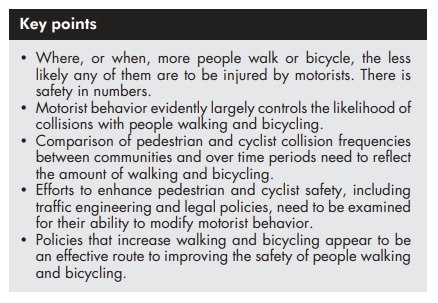There’s a reason why I feel more safe riding my bicycle in Beverly Hills and Santa Monica than I do in other parts aroundLA, such as Mid-City or South Central. In West LA, motorists even treat me better while I’m atop a bicycle because they’re accustomed to seeing many of me, or even, they themselves are me in their leisure!
I can tell when I’m in an area where more people bike, whether it be for work commutes or only for fun, by both the infrastructure of the roads and the attitudes of the folks. But hey, that’s my personal perception and attitudes are subjective, and this isn’t the opinion column, so let’s get to the facts..
My buddy ChatGPT, with my human guidance of course, has simplified and summarized an article from a peer reviewed medical journal, Injury Prevention, for your reading pleasure. A PDF of the original article is available by clicking the hyperlinked title within the opening paragraph. Isn’t the Internet great?!
Understanding the Dynamics of Walking and Bicycling in Los Angeles
In bustling cities like Los Angeles, where motor vehicle collisions are a significant concern, understanding the dynamics of walking and bicycling becomes crucial for ensuring public safety. Peter Lyndon Jacobsen's article, "Safety in numbers: more walkers and bicyclists, safer walking and bicycling," sheds light on the complex relationship between pedestrian and bicyclist injuries and the volume of walking and bicycling in urban areas. By examining this research through the lens of Los Angeles' unique urban landscape, we can glean insights into fostering safer streets and promoting an active, healthy lifestyle in the city.
The Relationship Between Walking, Bicycling, and Collisions: Jacobsen's research challenges the intuitive notion that more pedestrians and bicyclists lead to a proportional increase in collisions. Contrary to this assumption, his findings suggest a non-linear relationship, indicating that as the number of walkers and bicyclists increases, the likelihood of collisions diminishes. This phenomenon, observed across various geographic scales, underscores the importance of human behavior in shaping road safety outcomes.
Less people in personal motor vehicles, and/or people in motor vehicles less often, results in a more safe community for us all! | screen capture: Safety in numbers: more walkers and bicyclists, safer walking and bicycling — Injury Prevention Journal
Insights from Data Analysis: Examining data from California cities, Danish towns, and European countries, Jacobsen demonstrates that the rate of pedestrian and bicyclist injuries decreases as the volume of walking and bicycling rises. This inverse relationship highlights the role of behavioral adaptation, particularly among motorists, in mitigating collision risks. Furthermore, time series analysis from the United Kingdom and the Netherlands reveals how changes in walking and bicycling patterns correlate with fluctuations in collision rates, emphasizing the dynamic nature of road safety dynamics.
Implications for Los Angeles: Applying Jacobsen's insights to Los Angeles, a city known for its diverse transportation landscape, holds immense potential for enhancing pedestrian and bicyclist safety. As initiatives to promote walking and bicycling gain traction in the city, policymakers can leverage this research to inform urban planning strategies and infrastructure investments. By fostering a culture of active transportation and encouraging motorists to be more cognizant of vulnerable road users, Los Angeles can create safer streets for all residents.
Expanding the Discussion:
1. Urban Mobility in Los Angeles
Los Angeles is renowned for its sprawling urban landscape and heavy reliance on motor vehicles. However, as the city grapples with traffic congestion and environmental concerns, there's a growing momentum to promote alternative modes of transportation, such as walking and bicycling. Jacobsen's research provides valuable insights into how these shifts in mobility patterns can influence road safety outcomes in a city as diverse and dynamic as Los Angeles.
2. Analyzing Safety Trends
By examining data on pedestrian and bicyclist injuries in California cities, including those in the Los Angeles metropolitan area, we can discern patterns that shed light on the efficacy of safety measures and infrastructure investments. Identifying high-risk areas and understanding the factors contributing to collisions can inform targeted interventions aimed at improving safety for vulnerable road users.
3. Urban Planning and Infrastructure Development
Los Angeles has made strides in recent years to enhance its pedestrian and bicyclist infrastructure, with initiatives such as Vision Zero aimed at eliminating traffic fatalities. Jacobsen's research underscores the importance of integrating safety considerations into urban planning and infrastructure development projects. From implementing protected bike lanes to enhancing crosswalk visibility, there are various strategies that Los Angeles can adopt to create safer streets for all residents.
4. Promoting Active Transportation
Encouraging walking and bicycling as viable transportation options is not only beneficial for road safety but also for public health and environmental sustainability. Jacobsen's findings provide empirical support for the "safety in numbers" phenomenon, wherein increased walking and bicycling activity leads to safer streets through heightened awareness and behavior adaptation among motorists. In Los Angeles, initiatives to promote active transportation, such as CicLAvia events and bike-sharing programs, play a pivotal role in fostering a culture of sustainable mobility.
5. Community Engagement and Advocacy
Achieving meaningful progress in pedestrian and bicyclist safety requires collaboration among stakeholders, including government agencies, advocacy groups, and community members. Jacobsen's research serves as a catalyst for dialogue and action, prompting discussions on policy reforms, public education campaigns, and community-driven initiatives aimed at prioritizing the needs of pedestrians and bicyclists in urban planning processes.
Final Spin
In conclusion, Jacobsen's research offers valuable insights into the complex relationship between walking, bicycling, and road safety. By contextualizing these findings within the framework of Los Angeles' urban landscape, we can discern actionable strategies for creating safer, more accessible streets for all residents. From infrastructure improvements to community engagement efforts, Los Angeles has the opportunity to lead the way in promoting active transportation and fostering a culture of sustainable mobility.
References: Jacobsen, P. L. (2003). Safety in numbers: more walkers and bicyclists, safer walking and bicycling. Injury Prevention, 9(3), 205–209. https://doi.org/10.1136/ip.9.3.205

